At its brightest Comet NEOWISE was an easy naked eye object, such a big and bright comet that even people who had no previous experience of stargazing or sky-watching could see it hanging there in the sky, a feather-tailed 'star' glowing down to the lower right of the familiar stars of the Plough.
But now, after delighting experienced comet observers and non-astronomers alike all over the northern hemisphere for weeks, sporting a curved yellow dust tail and torch-beam blue ion tail, both of which showed up beautifully through binoculars and in long exposure photographs, Comet NEOWISE f3 is fading, and fading fast.
- View our online gallery of Comet NEOWISE images.
After surviving its whip around the Sun (and what a relief that was after several recent comets fell apart as they rounded our star) F3 NEOWISE reached peak magnitude of around 1 as it barrelled towards us,
Having passed Earth on 23 July, the comet is now heading away from us again, returning to the cold, dark depths of the outer Solar System. The latest estimates by experienced observers place F3’s magnitude at 4 or lower.
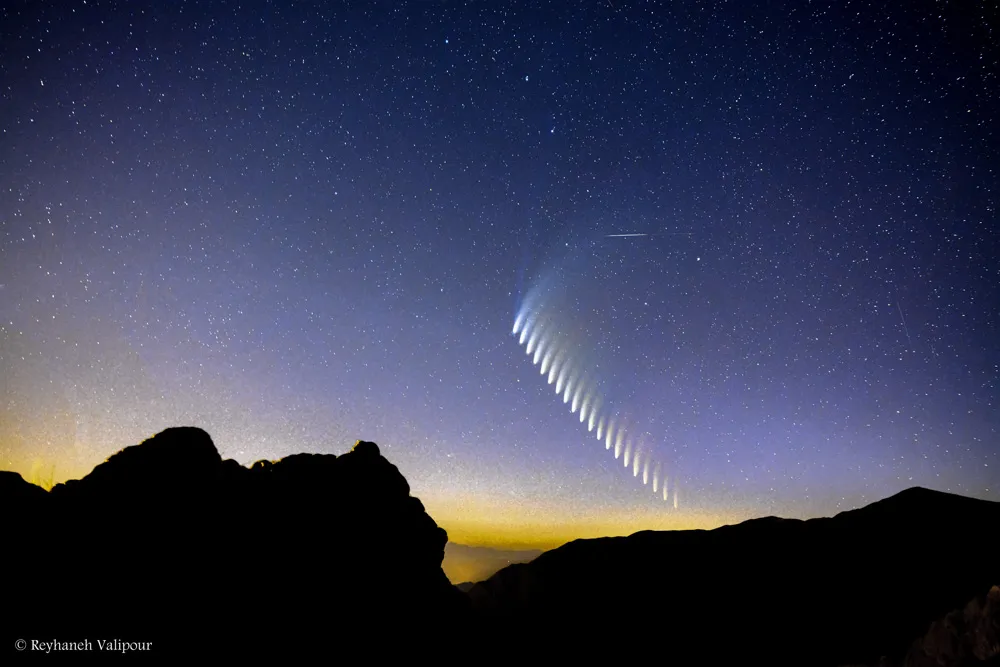
That means it is still technically a naked eye comet, but in reality, with the amount of light pollution most people now have to live with, only observers blessed with very dark skies can now see it without having to use binoculars or a small telescope.
Its tails have also furled up somewhat, making it smaller and less obvious in the sky.
That’s not to say it’s not still worth looking for. Although F3 is a shadow of its former self visually, its tail is still evident, its head is a beautiful green colour and it is a sublime sight through telescopes.
- Read our guide: 10 great comets of recent times
It’s important to remember that having a magnitude 4 comet in the sky is a rare event; if this had been NEOWISE’s peak brightness we’d have happily taken that after years and years of having to hunt down 7th and 8th magnitude puffballs in our binocular and telescope eyepieces.
F3 is still there, a v-shaped smudge glowing beneath the stars of the Plough, and it is still definitely worth looking for and will be pretty sight in binoculars and telescopes for a while yet.
And it will continue to be a great photographic target, especially for astrophotographers who can take long exposures using motorised mounts that can track the stars.
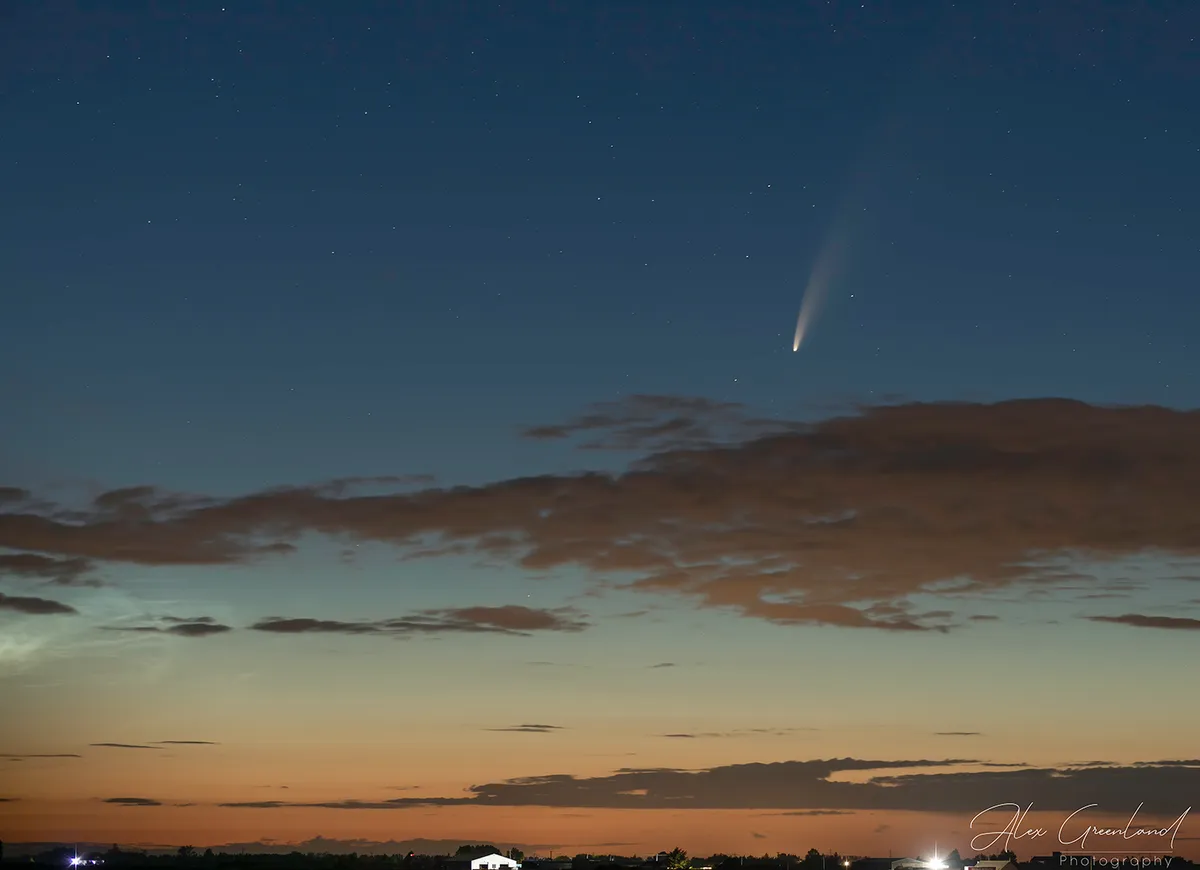
After the frustrations of comets SWAN and ATLAS earlier in the year, F3 NEOWISE has been a real – and much-needed – treat for northern hemisphere comet observers.
It seemed to take ages to actually drag itself up into our sky, but as it approached Capella the first observer reports began to trickle in.
As the first photos of Comet NEOWISE were taken, showing the comet had not just survived its perihelion swoop around the Sun but had come out the other side in great shape, with a bright head and shining tail that were obvious even in the pre-dawn sky, we began to think that maybe, just maybe, we were about to see something special. And we did.
At its best F3 was a genuinely beautiful sight, looking like a smaller, slimmer version of Hale-Bopp which lit up the sky a quarter if a century ago.
Observers lucky enough to be able to gaze up at it from a dark sky location were struck by how big F3 looked in the sky, with its long, long tail looking much more impressive than we had dared hope.
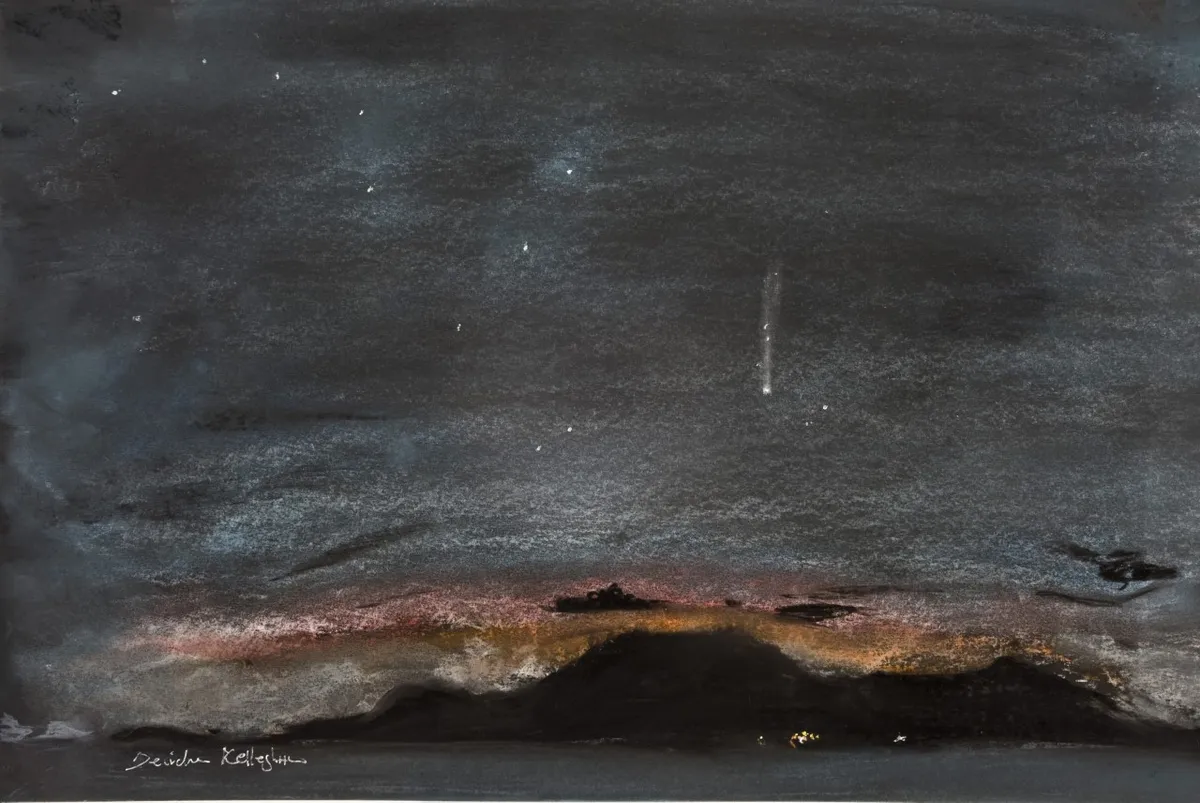
Comet NEOWISE: astrophotographers' delight
F3 might well go down in history as the most photographed comet ever. From the high plains of the US to the mountains of the Italy and beyond, astro-photographers trained their cameras on it and were amazed by what they saw even just on their camera screens.
After processing their images back home, many comet-chasers could not believe just how beautiful NEOWISE was.
Some were happy to just record details in the comet’s tail and coma, zooming in on them with long lenses and telescopes. Others took rather more artistic images, showing the comet reflected in lakes, shining above mountains or even being caught by the outstretched hands of a child.
Meanwhile, in towns and cities across the world, in farm gateways, parks and school playing fields, non-astronomers found that the comet was big and bright enough to not only find easily but take photographs of it with just the camera on their mobile phone.
Many of these images are as good as the ones taken of Hale-Bopp with the film cameras of the late 90s. Despite some complaining that there were too many photographs being taken of the comet (yes, seriously) each image is special, and every one will be treasured forever by the person who took it.
Comets as bright as F3 are rare, and it might be years before we see anything like it in the sky again, so well done to everyone who took a photo of NEOWISE. Be proud of your picture of your comet.
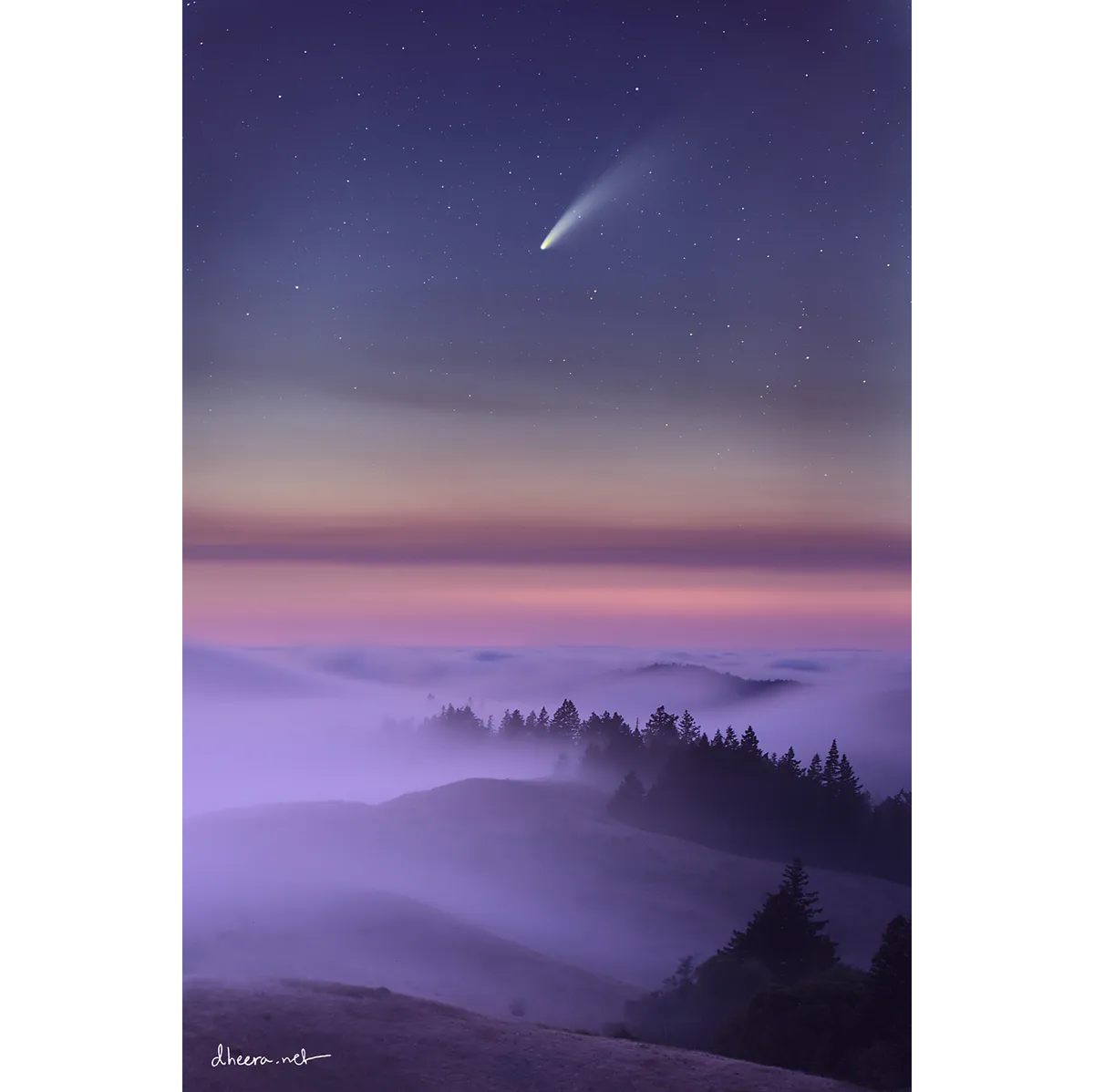
For how long will Comet NEOWISE last?
So what happens next? Well, it’s important to remember that NEOWISE hasn’t gone! It’s still there, drifting beneath the stars of the Plough.
Yes, it has faded, a lot, and is only going to get fainter, and the day when it can no longer be seen through binoculars and it becomes a sight reserved for telescope-owners again is not too far away.
But until then, do try to see it up there as it drifts through the stars of the Great Bear. Follow it as long as you can. None of us will be here when it comes this way again, in 6,800 years.
And as Comet NEOWISE F3 fades, and takes its place in the history books, think about this. As beautiful as it has been, it is really just the warm up act for the next Hale-Bopp, the next Great Comet, a comet that will put F3 to shame.
Imagine standing in the very same place where you looked at and photographed NEOWISE and seeing a comet four, five, ten times bigger in the sky than F3, with a tail as long as your outstretched arm that spans not just one but several constellations.
Imagine a comet with a head so bright that it can be seen clearly straight after sunset, even during the daytime as a golden 'star' close to the Sun.
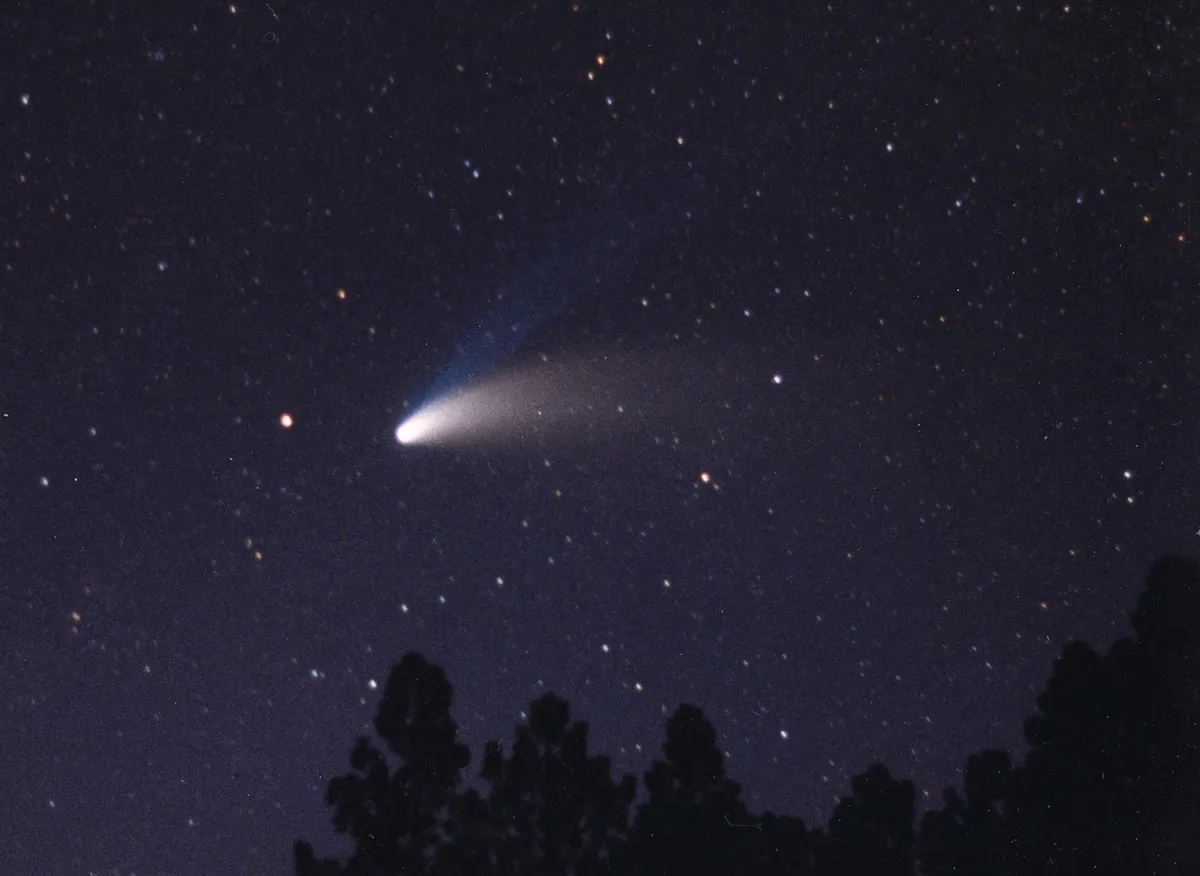
Imagine driving out away into the countryside at the end of a long work day, leaving all the streetlights and factory security lights behind you, getting out of the car and seeing a comet in the sky so bright and with a tail so long that it looks like a WW2 search-beam. That’s what lies ahead of us.
When? No idea. But it will happen, one day. Because even as F3 heads back into the depths of space, returning to its millennia-long hibernation, somewhere out there is another comet that is destined to astound the world.
Right now it is just a frozen ball of gas and dust, billions of miles away from the Sun, invisible in the darkness, frozen to its core. But it is coming towards us, and one day it will be picked up by a survey and when its numbers are crunched it will start to look very interesting indeed.
And months – perhaps years – later, it will be painted on the sky like a work of art and put on such a show that it will fill parks, cover hillsides and cram playing fields with people who think it is the most beautiful thing they have ever seen.
In the meantime, NEOWISE is still there, still a thing of rare beauty, so get out and look for it as long as you can.
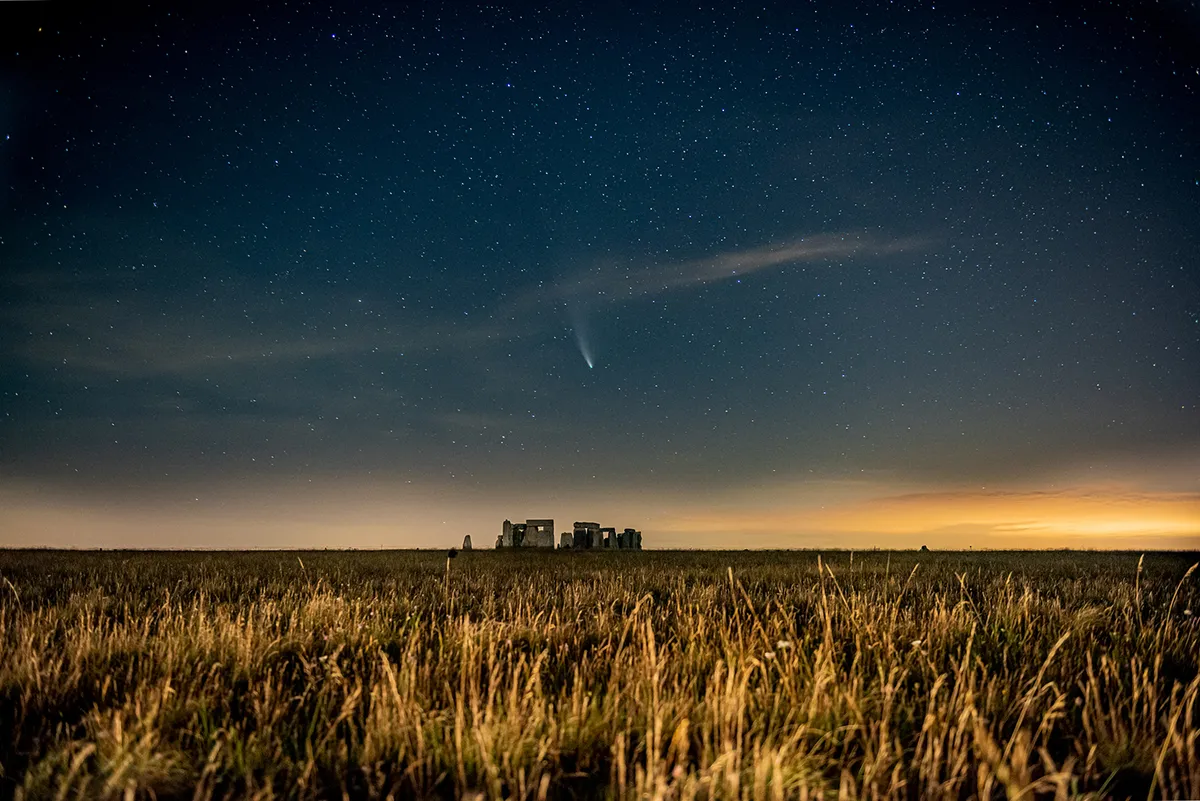
What made Comet NEOWISE so special?
Words: Pete Lawrence
Comet C/2020 F3 Neowise has proven that comets don’t always follow the rules. Typically, the comet rule-breakers either naturally fail to make their predicted brightness or disintegrate as they approach their closest position to the Sun, perihelion. F3 Neowise is one of those rare comets that did the opposite and actually got better as it passed perihelion, brightening and putting on something of a show.
As it moved into a position where it could be seen in the early morning sky above the UK’s north-northeast horizon, to the naked eye it showed a bright head with a distinct tail, stretching back away from the Sun.
Bad weather then took over with a string of cloud-filled weather systems moving across the UK from the Atlantic during the week commencing 6 July.
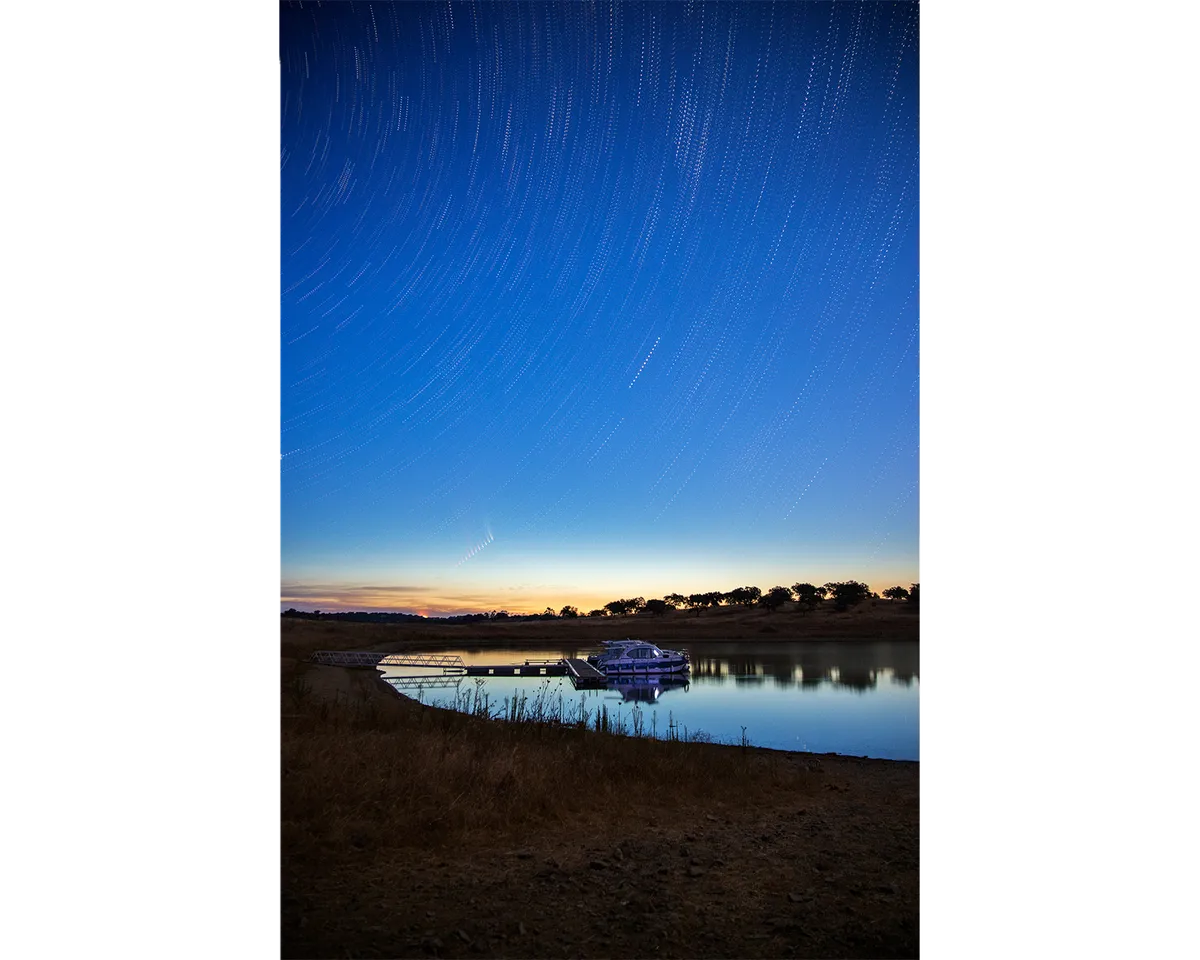
Early predictions suggested the evenings of 10/11 and 11/12 July would be clear for much of the UK, thanks to a small area of high pressure moving across the country. The predictions came good and many got their first sighting of comet F3 Neowise. Indeed, for many this was their first sighting of a comet at all.
Moving forward, the situation is dynamically balanced. Having passed perihelion on 3 July, F3 Neowise is now receiving less energy from the Sun so its activity should be waning.
However, from the UK the comet is climbing higher in the sky and, for early morning views at least, the bright Moon is becoming less intrusive.
Couple this with the fact that F3 Neowise is actually getting closer to the Earth and things remain quite exciting. The comet’s closest approach to Earth will be on 23 July, when it’ll pass our planet by 103 million km.
During the remaining part of July, the nights will slowly draw in, giving the comet a slightly darker background to further assist with its visibility.
F3 Neowise tracks below the Plough during the last half of July and this famous asterism can be put to good use in order to find it. By looking at the chart below, it’s possible to estimate where the comet will be in relation to the Plough, and to use sections of the pattern as a cosmic ruler.
For example, mid-July the comet can be found by extending a line from the end of the handle (far left of the pattern as shown) through the edge of the Plough’s blade (right hand side of the pattern as shown) for the same distance again.
Then, around 24 July, it sits roughly one Plough handle’s length below the Plough’s blade. And so on.
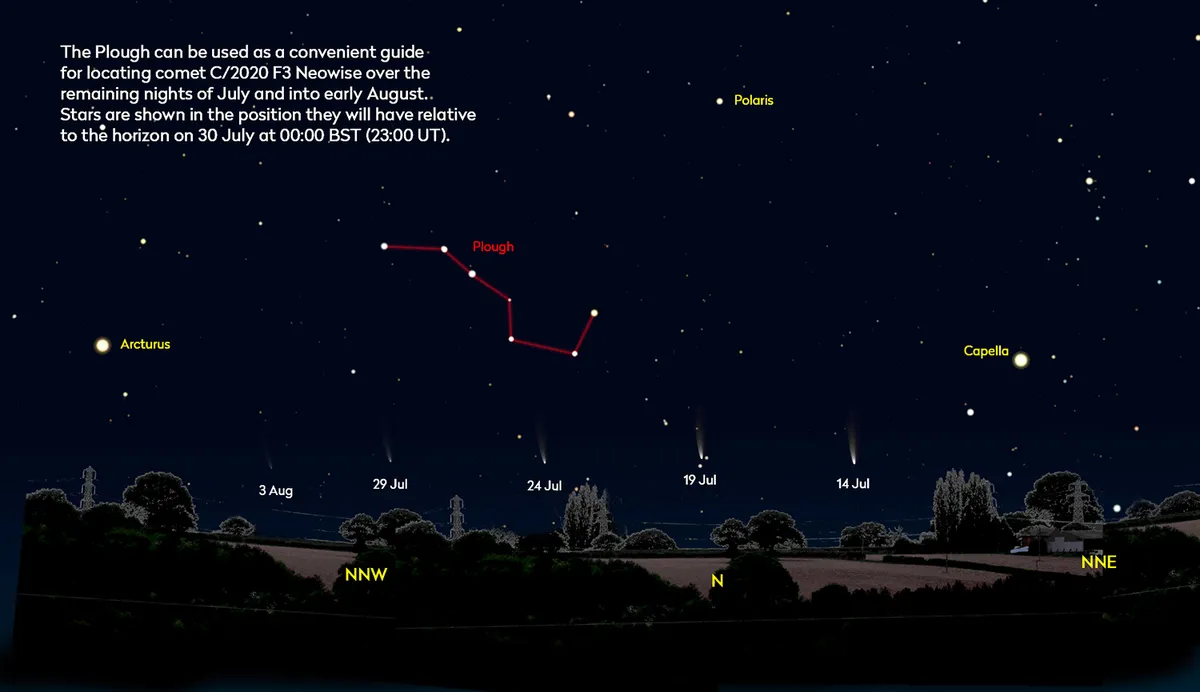
What will Comet NEOWISE be like over the coming nights?
What will happen over the following nights isn’t entirely clear. At the time of writing, the comet remains relatively bright and visible to the naked eye. It’s not certain how long it will be able to maintain this status but with luck it’ll remain so for much of July.
After it fades from naked eye brightness, it’ll still be visible with binoculars and telescopes for a while longer of course.
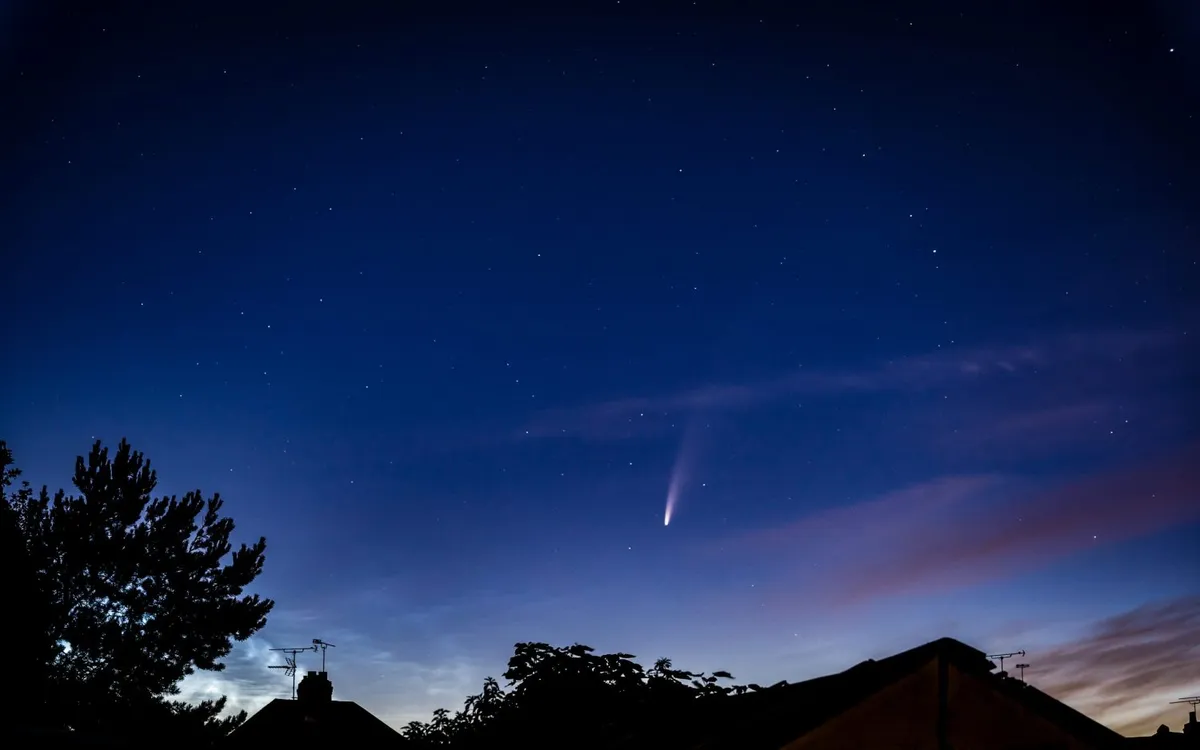
A little bit of comet science...
A comet evolves when its nucleus receives sufficient energy from the Sun to begin the process of sublimation, basically a physical process which turns frozen material directly into a gas without going through the liquid phase. This releases frozen gas and dust trapped in the comet’s nucleus.
As the nucleus rotates, this material gets wrapped around the nucleus to form what’s known as the coma. A bright central region within the coma represents the densest part of the envelope surrounding the nucleus. This is known as the pseudo-nucleus.
Radiation pressure on the dust particles within the comet’s coma, pushes them away from the comet’s head. Further from the Sun than the nucleus, these particles take on larger and slower orbits.
Over time this causes the expanding trail of dust to curve away from the comet’s head into a spectacular, fan-like dust tail.
Variations in the outgassing from the nucleus can become magnified during this process, appearing like striated regions within the dust tail. These go by the rather lovely name of synchronic bands.
In addition to the dust tail, charged particles within the solar wind encountering gas within the comet’s head, cause ionisation.
The resulting electrically charged atoms stream out of the comets head, exhibiting a characteristic blue glow to form what’s known as the gas or ion tail.
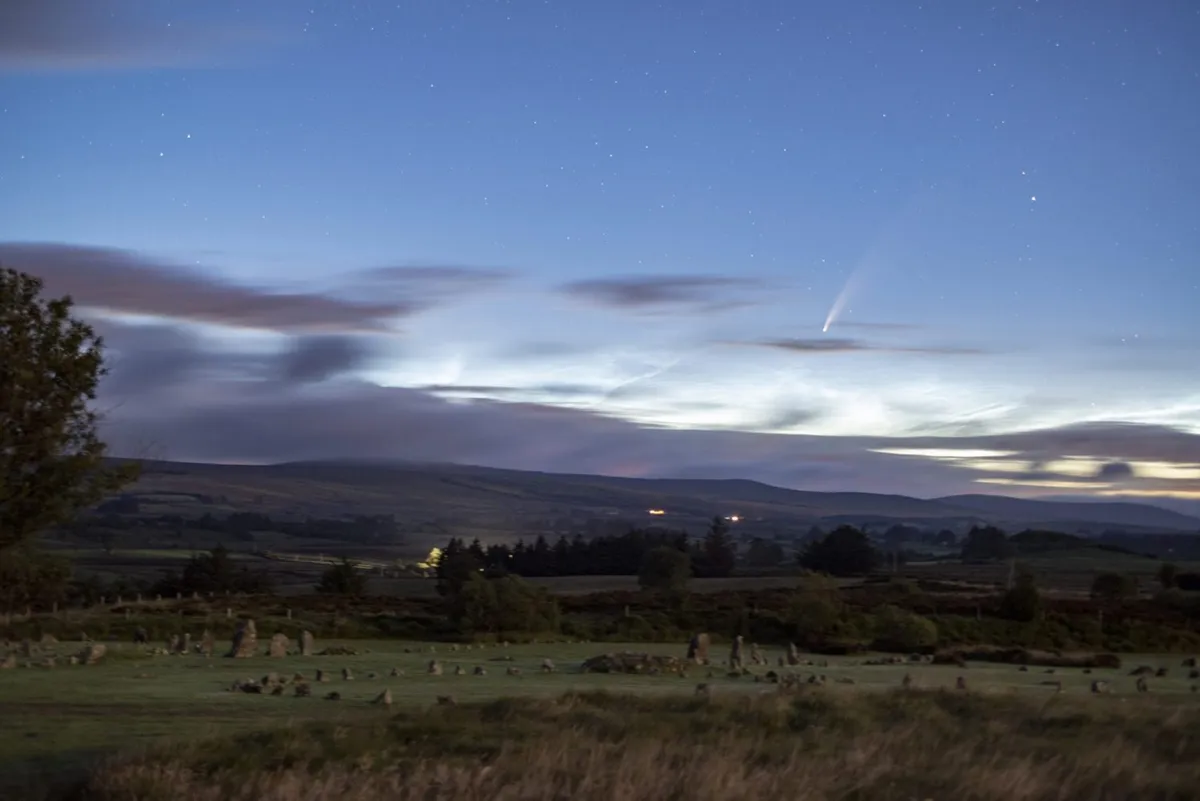
Compared to the expanding fan-shaped dust tail, the ion tail is very thin and very straight. In the case of F3 Neowise at the time of writing (mid-July) the ion tail is present but much fainter than the dust tail.
Variations in the solar wind may cause the ion tail to disconnect from the coma. Known as a disconnection event, the broken off portion of the ion tail merrily sails away from the comet’s head, while a new ion tail is formed.
Whether any of these events occur with F3 Neowise remains to be seen, but in this case, whenever the skies are clear, there’s always someone who will be looking.
In order to document the comet’s activity over coming days, it’s important to at least specify the date and time of any drawings, descriptions or photographs you make (for more on this, read our guide on how to keep an astronomical log book).
It also helps to give an idea of the equipment used to make the observations and, in the case of any photographs or sketches, the approximate size of the field of view.
A close-up view of the comet’s head may show completely different details to a wide field image which records the entire extent of the comet’s tails.
Pete Lawrence is an experienced astronomer and co-host of The Sky at Night.
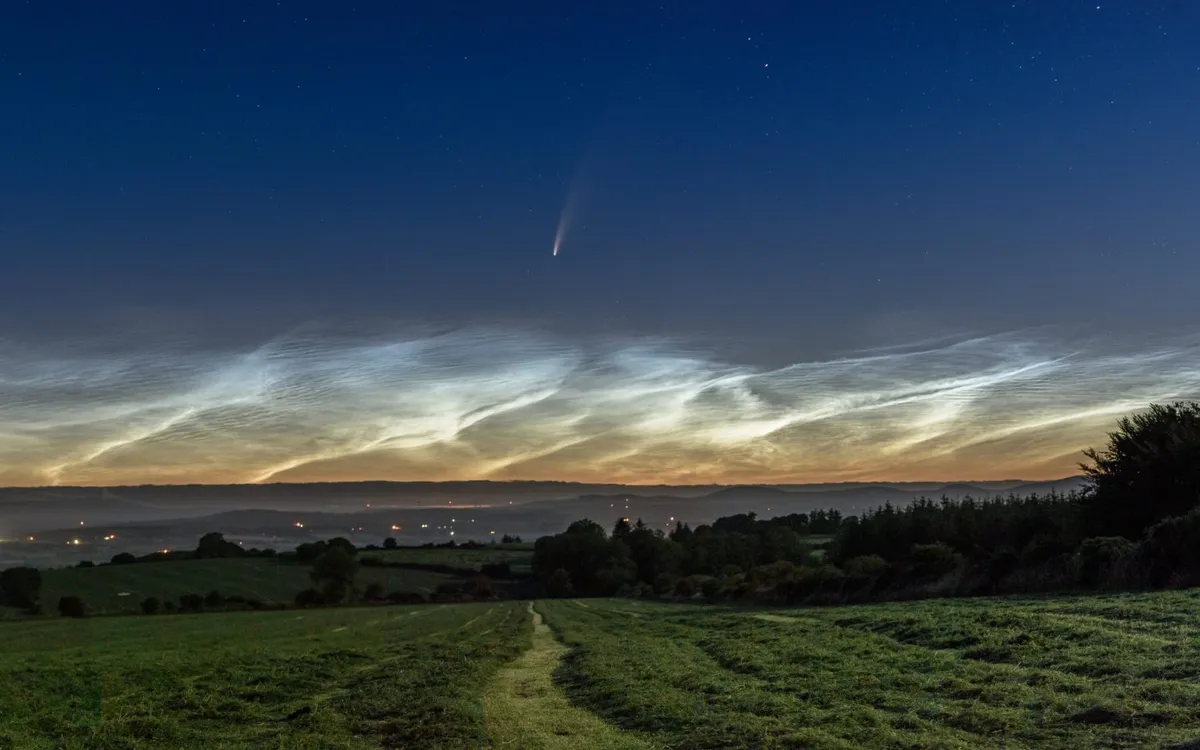
Tracking Comet NEOWISE's early brilliance
The following was originally published on 6 July 2020, when NEOWISE was at its peak as an observable object. Words: Stuart Atkinson
Millions of people are gazing up and falling in love with Comet C/2020 F3 NEOWISE. After a drought of many years, there was cautious optimism about Comet NEOWISE and whether it would show up, but as a flurry of headlines, images and online articles is making abundantly clear, it's a fantastic sight to see in the northern sky.
NEOWISE reached perihelion - its closest point to the Sun - on 3 July 2020, and will make its closest approach to Earth almost 3 weeks later on 23 July 2020, when it will be passing us at a distance of 0.69 AU (103 million km).
That’s close in cometary flyby terms but is still more than 400 times further away than the Moon.
As it rounded the Sun we were hopeful that Comet NEOWISE would reach naked eye brightness but we weren’t sure, and we were still nursing bruises from earlier in the year when a couple of comets that had looked like they might become bright enough to see without binoculars or telescopes fizzled out and broke apart.
So news that Comet NEOWISE is bright enough to see with the naked eye came as a huge relief for comet observers in the northern hemisphere.
Ever since the twin-tailed, celestial peacock comet Hale-Bopp dominated the sky in the Spring of 1997, comet-watchers north of the equator have longed to see another bright naked eye comet in their sky, but have had to look on in frustration as southern hemisphere observers were treated to one show after another.
To rub salt into their wounds, a couple of recent comets that looked like they might become naked eye northern objects failed to live up to their initial promise and either fizzled like damp firework or just crumbled into dust.
So when number-crunching suggested Comet NEOWISE F3 had the potential to be a naked-eye comet, a lot of eyebrows were raised cynically and many observers mumbled “I’ll believe it when I see it…”
For comet chasers, this has made the appearance of NEOWISE all the more satisfying.
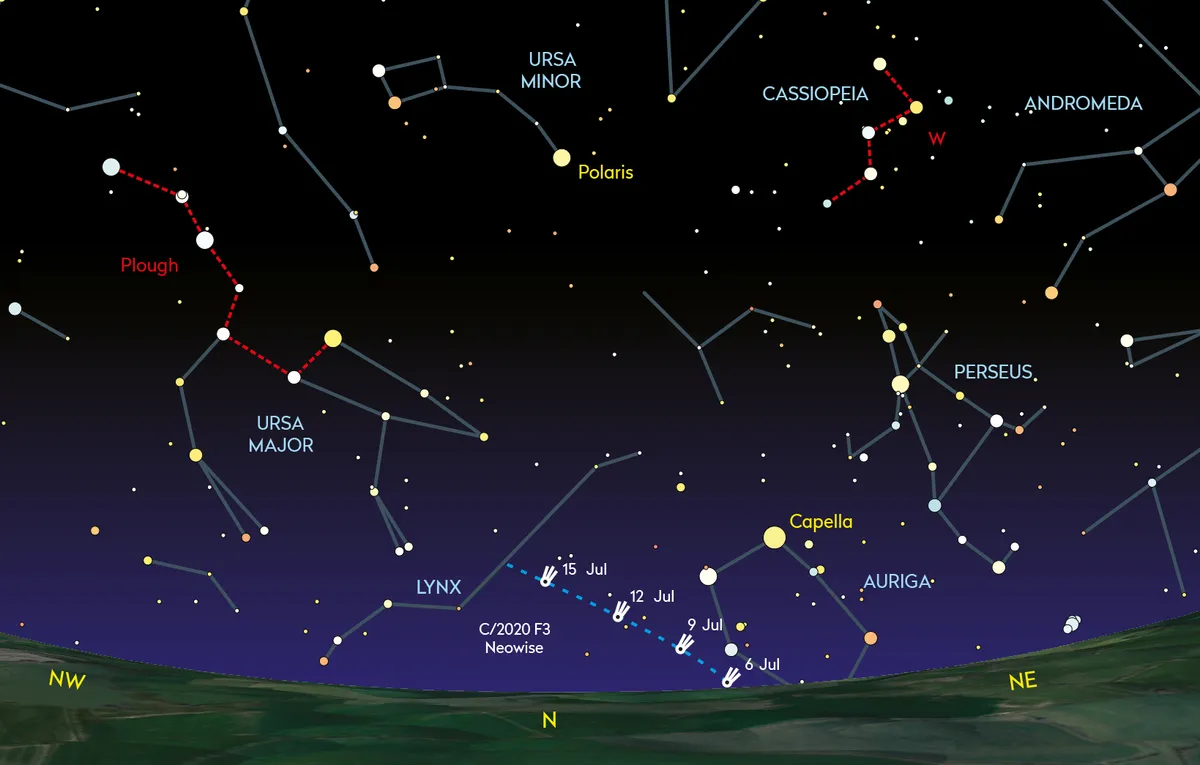
How can I see Comet NEOWISE?
Although NEOWISE isn’t a 'Great Comet' like Hale-Bopp, it is a great comet to look at and photograph. Having drifted up past Capella, the brightest star in Auriga, it is now well and truly a 'northern' comet, and easy to find due to its proximity to Capella and the stars of the Big Dipper.
Predictions that the comet might reach naked eye brightness, perhaps even second magnitude, were accurate and in fact the comet has exceeded those early expectations and is visible to the naked eye even from towns and cities
It seems to have peaked at around 1st magnitude, meaning many non-astronomers have been able to find it without knowing a single constellation or star, just by going outside, facing the north and looking for “the star with a tail”.
After initially being just a morning object, for observers in mid-northern UK latitudes the comet is now visible low in the north all through the night, from dusk to dawn.
It is now starting to climb higher in the sky, heading up towards the stars of the Big Dipper, but it will never get very high in the sky.
However, no-one is complaining about that. To be able to just go outside, look to the north and see a naked eye comet glowing there, with a proper tail, is a real treat.
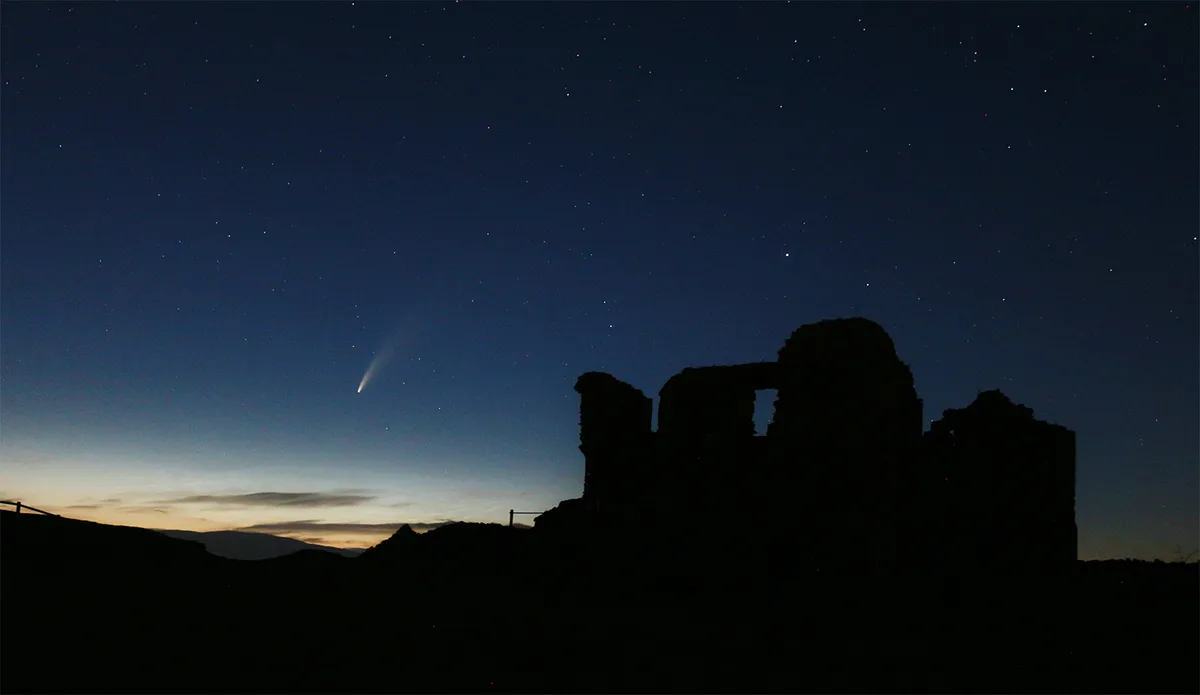
What does Comet NEOWISE look like?
If you haven’t seen Comet NEOWISE yet it really is easy to find. On the next clear night, go out as the sky begins to darken, around 11pm, look roughly to the north, and eventually you’ll see a star with a fuzzy tail behind it, pointing up from the horizon.
If you can’t see it just wait a while longer until you can see some stars, then find the Big Dipper, look to its lower right, and the comet will be there, to the left of bright Capella.
By 1am, in a darker sky, through binoculars and telescopes the comet tail will look like a beam of light shining from a head torch, but on a much smaller scale obviously.
By 4am the sky will become so bright with the approach of dawn that it will wash the comet from the sky, but the next night it will still be there, a little higher and a little closer to the Big Dipper.
To the naked eye NEOWISE is a classic comet, straight from the astronomy textbooks. Once the sky gets dark enough for it to pop into view, it looks like a star with a long, misty tail streaking away from it, and the darker the sky gets the more impressive it looks.
At the time of writing observers are reporting its tail is more than 10 degrees long to the naked eye, and long exposure photographs are showing it is much longer than that.
Through binoculars and small telescopes the comet is a wonderful sight, shining a subtle golden colour and showing a lot of detail around its nucleus.
Comet NEOWISE’s brightness seems to be holding, and its tail is continuing to grow, so it should be clearly visible to the naked eye until the end of the month, but even if it does start to fade soon (and it must!) I’m sure it will remain a lovely to view through binoculars and telescopes for a while yet.
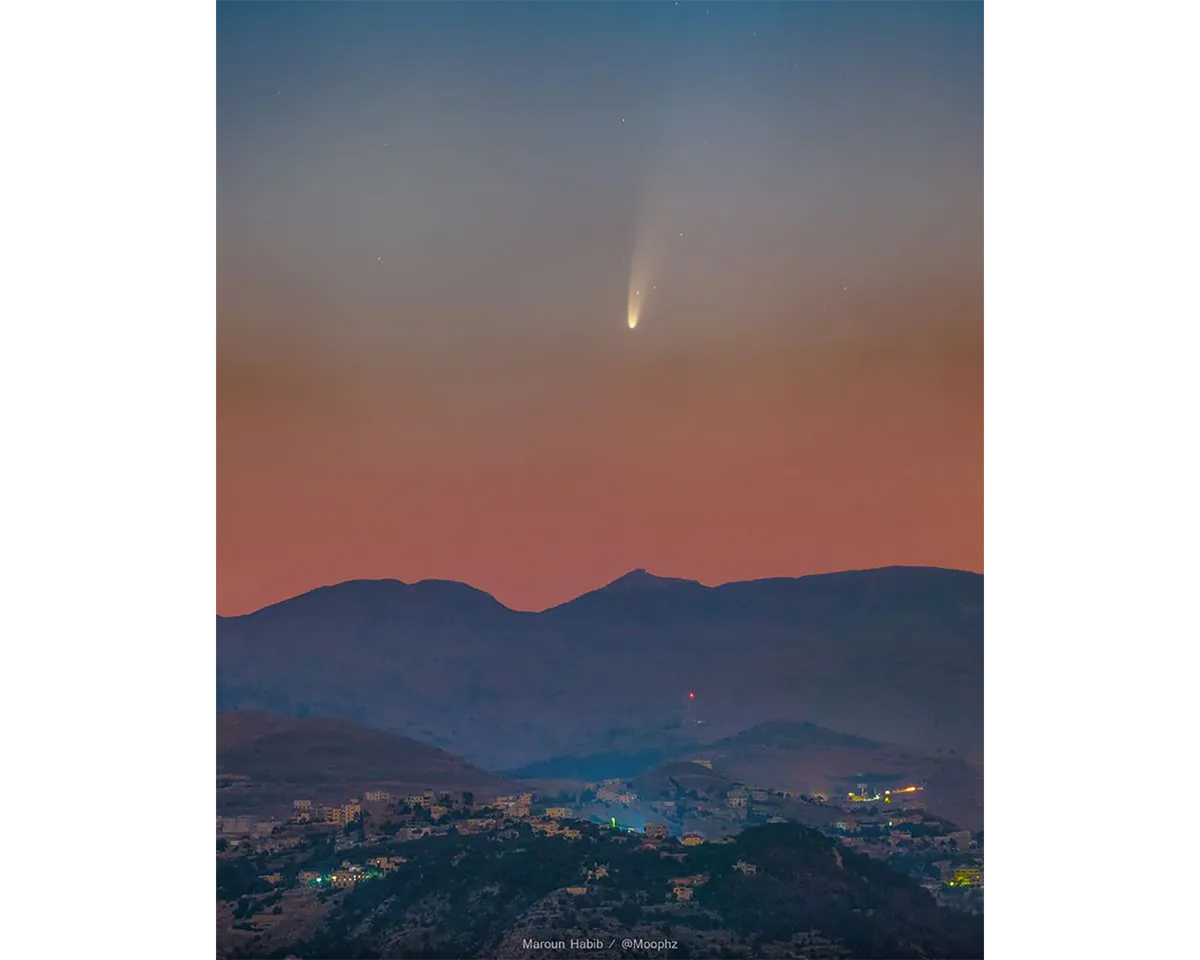
Comet NEOWISE making headlines across the globe
People are making the most of it too. Social media is groaning under the weight of photos of the comet taken from across the world, many of them quite beautiful.You can follow the latest updates on Twitter with the hashtag #CometNEOWISE.
Last weekend, after a long spell of dreadful weather UK observers were able to join the party, and from the Scottish Highlands to the Isle of Wight, comet observers have been staying up late and getting up early to see and photograph the icy celestial wanderer found earlier this year by the NEOWISE telescope.
And on 10 July an image was released of Comet NEOWISE captured by the Parker Solar Probe.
As if it wasn’t enough to have a naked eye comet in their sky, many observers were treated to the sight of that comet shining behind a veil of spectacular electric blue noctilucent clouds too!
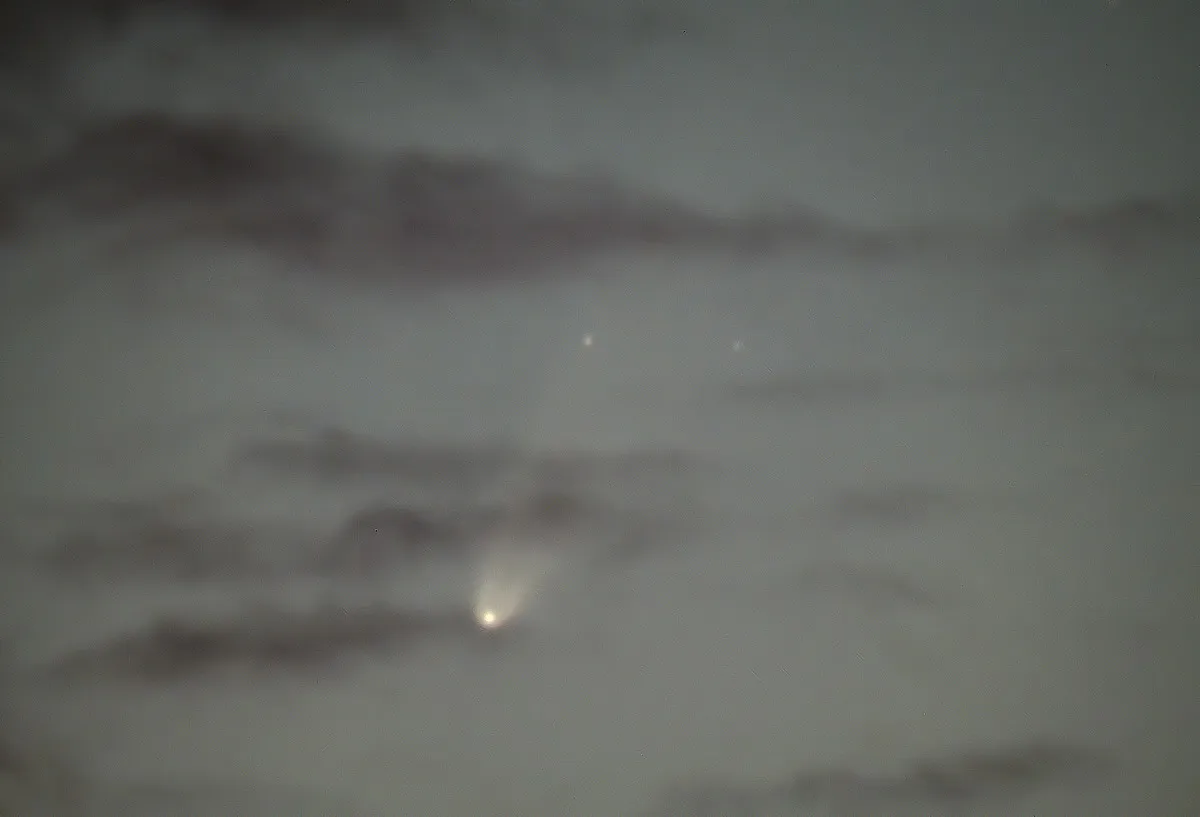
How to photograph Comet NEOWISE
To capture it as anything more than a smudged star you’ll probably need a DSLR set to a high ISO, mounted on a steady tripod, fitted with a lens of between 50mm and 200mm aperture.
After focussing sharply on the horizon, take some test exposures of a second or so. If the comet doesn’t show on your images, change the ISO and exposure settings until it does.
If we’re lucky, in mid-July we’ll all be taking lovely photos of Comet NEOWISE’s tail pointing up towards the stars of the Big Dipper.
We’ll keep you updated about the comet’s progress, but if you want to take your own photos of the comet a DSLR on a tripod, taking time exposures of several seconds, will give great results, especially if you take lots of photos and stack them together using computer software.
But the comet is so bright that many people are taking photos of it with just their mobile phones, so give it a try with yours.
Enjoy Comet NEOWISE F3 – it will be gone all too soon, and we probably won’t see a comet as good as it for a long time.


